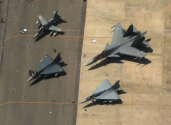40 Tejas MK1A out of 180 will have ELTA 2052 and rest will have UTTAM AESA Radar, UTTAM is a Gallium Nitride Aesa Radar, ELTA is Gallium ArsenideSo what's current Tejas have ? like do they already received the EL/M-2052 AESA or Uttam now ? Or that will be in future Mk1A ?
You are using an out of date browser. It may not display this or other websites correctly.
You should upgrade or use an alternative browser.
You should upgrade or use an alternative browser.
Indian Military News, Reports, Data, etc.
- Thread starter bd popeye
- Start date
It's not just that, but the entire Gripen platform, such as the EW Arexis suite, the WAD human machine interface, HMD Targo II, TIDLS among several other systems and subsystems that make Gripen superior.I know the answer to the questionand there are certainly more advantages to Gripen.
The first problem is, our Indian friend quite clearly doesn't know replies, his replies being tied around to a single one-trick answer, which is neither verifiable, nor comparable, nor does he understand what this number actually means.
The econd problem - those capabilities don't make the small fighter the most capable. They're offsets, which, in certain situations, may play to Gripen's advantage.
The combat range of the Gripen is 1,300 kilometers, while the F-16's combat range is only 550 kilometers. The Gripen can carry a payload of 7.2 tons, compared to the F-16's payload capacity of 7.6 tons. The Gripen airframe contains a higher percentage of carbon composites, making it lighter and giving it a smaller radar cross-section (RCS) than the F-16. Additionally, the Gripen requires a shorter runway for takeoff and landing and is more maneuverable.Answer specifically please, preferably with links. Specific things that Gripen can do that, say, Viper V can't. And how they compensate for multiple opposites.
As you said, being over 10 years old should be enough for that.
F-16 was designed 60 years ago, while the Gripen, Rafale, Eurofighter Typhoon, and Tejas MK1 are modern designs. The Tejas MK2 will be the latest 4th generation fighter jet. It is projected to have an RCS of only 0.1 square meters and will be capable of carrying 8 BVR missiles on its wings and 2 BrahMos missiles under the belly.It's not just that, but the entire Gripen platform, such as the EW Arexis suite, the WAD human machine interface, HMD Targo II, TIDLS among several other systems and subsystems that make Gripen superior.
40 Tejas MK1A out of 180 will have ELTA 2052 and rest will have UTTAM AESA Radar, UTTAM is a Gallium Nitride Aesa Radar, ELTA is Gallium Arsenide
Again „will have“!! And you surely again feel proud since „will have“ on paper maybe in the future equals for you „is the best“ already now!
Can we stop with this kindergarten-like posts?
Last edited:
And yet Gripen lost competition in Switzerland(!) in a2a category because of range - it couldn't even reach the furthest corners of the country half the size of Chongqing. Surely, with 1300 km of range, it should be able to fly combat missions to Moscow and back?The combat range of the Gripen is 1,300 kilometers, while the F-16's combat range is only 550 kilometers.
Like, maybe (hint) you're comparing two incomparable numbers?
7.2t number for Gripen E is basically MTOW minus empty weight. Which is very technically right, but de facto it's a commercial trick - what should matter is usable payload @ range.The Gripen can carry a payload of 7.2 tons, compared to the F-16's payload capacity of 7.6 tons.
A similar number for F-16 from blk 50/52 onwards is around 11.5t, not 7.6t.
You don't know the exact numbers, even if it's not unreasonable to expect Gripen to have a smaller RCS frontally. But how much smaller, and is it small enough to matter anything - is a very tricky subject. What we know for sure, though, is that SABR is simply a larger array.The Gripen airframe contains a higher percentage of carbon composites, making it lighter and giving it a smaller radar cross-section (RCS) than the F-16.
Lower RCS relationship with the composite percentage in the airframe is about the same, as the correlation between summer icecream sales and increase in crime rate.
Composite % is about weight.
…and will be capable of carrying 8 BVR missiles on its wings and 2 BrahMos missiles under the belly.
My friend, slowly I have enough of your most often funny but in the end simply „chest-bumping“ stupid posts. The Tejas will NEVER EVER carry 8 AAMs AND two Brahmos (in fact none of the current ones).
As such take this as a very clear warning: either your posts must dramatically improve in quality or I‘ll send you on vacation for trolling and reconsider.
To be fair, most flankers can't because they don't have pylons rated heavy enough (and overall their lift capability limitations are about weapon setups to meaningfully load them).Not even a massive aircraft like the Flanker is capable of carrying two Brahmos-type missiles but the Tejas totally will be able to carry two of a missile almost as big as the plane, lol
Su-34 can take 3 weapons of this weapon class (and there are reasons to suspect 5), and much higher combat payload capacity in a more or less same aerodynamic design. That came at a price, though - beefing up a spacious airframe came at a significant weight penalty.
Also, forTejas the weapon in question is the much smaller future Brahmos-NG, which is much smaller and lighter.
Two weapon capability is indeed the intent, made possible by the impressive weight-lifting capability of the small fighter.
In practice, this probably will rather mean the capability to fly with 1 big fuel tank + 1 missile to a moderate range...which won't be acted on, unless INAF is in a really desperate situation.

